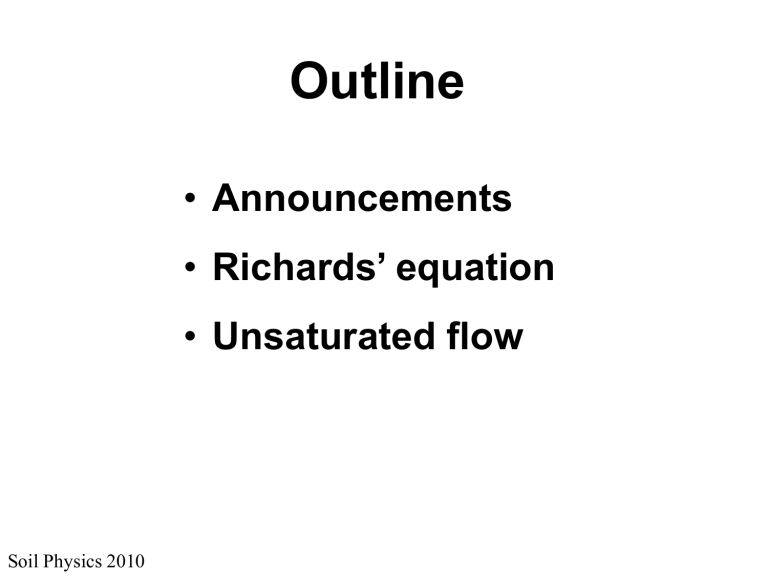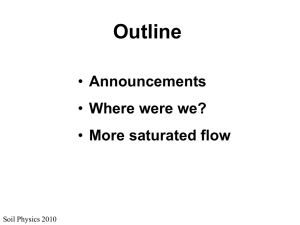Unsaturated flow - Soil Physics, Iowa State University
advertisement

Outline • Announcements • Richards’ equation • Unsaturated flow Soil Physics 2010 Announcements • Homework 4 due March 3 • Excel Solver demo on course website • Soil Physics 2010 Quiz! Question 1 Drying h Wetting q Soil Physics 2010 Question 2 Soil Physics 2010 Different lines show different possibilities h h 0 0 0 q 0 y Why different flow equations? Steady-state Transient Saturated Darcy’s law N/A Unsaturated Darcy’s law (with K(q)) Richards’ equation q changes with time No K(q) y Darcy’s law: q K A L Soil Physics 2010 No q No q(y) Equation of Continuity (Conservation of Mass) Steady-state Saturated Darcy’s law Unsaturated Darcy’s law (with K(q)) Transient Richards’ equation Input – Output = Change in Storage q x Soil Physics 2010 = q t q q x t Richards’ equation Given Darcy’s law: y qK L Let things change from place to place q y K x x x (say, in the x-direction) q q We also want conservation of mass x t So we substitute it in q K y to the left-hand side t x x Soil Physics 2010 Richards’ equation But this doesn’t allow K to change with q q y K t x x q y K q So we permit that, and… t x x voilà: Richards’ equation We can generalize it to 2 or 3 dimensions… q y y y K x q K y q K z q t x x y y z z Soil Physics 2010 … and add in anisotropy Richards’ equation Remember that the q y K q t x x y potential gradient, , x combines elevation, osmotic, pressure, and matric components (among others). Sometimes it’s q y K q 1 convenient to t x x separate out the elevation part: q K q y 0 t x x Vertical Horizontal Just remember that this y doesn’t include elevation! Soil Physics 2010 K(q), averages by texture Coarse soils: Lower f Higher Ks More abrupt drop Topp & Dane, Methods of soil analysis At low q: Small q → big K Huge range of K Huge uncertainty in K Soil Physics 2010 K(q) and K(y) for 3 textures (Mualem-van Genuchten functions) K(q) 1.E+02 K(y) 1.E+02 1.E-02 1.E+00 1.E-01 1.E+00 1.E-02 1.E-04 1.E-04 1.E+00 0 0.1 0.2 0.3 0.4 0.5 0.6 1.E-02 1.E+01 1.E+02 1.E+03 1.E+04 Sand clay loam 1.E-06 1.E-06 1.E-08 1.E-08 Sand 1.E-10 1.E-10 clay loam 1.E-12 1.E-12 1.E+04 1.E-14 1.E-14 Sand 1.E+03 clay 1.E-16 1.E-16 loam 1.E+02 1.E+01 1.E+00 0 1.E-01 Soil Physics 2010 1.E-02 0.1 0.2 q (y ) 0.3 0.4 0.5 0.6 K(y) has more hysteresis How do we measure K(q) in the lab? Ks is pretty easy. K(q) is slow, and hard to control. • Apply water at steady q < Ks • Wait till outflow = inflow • Measure q and/or y across a “test interval” Soil Physics 2010 • • • • • Prevent evaporation Water evenly, no disturbance Tall column, or tension at bottom Tensiometer can change flow Measure q with gamma-rays How do we measure K(q) in the lab? K(q) is slow, and hard to control. Other methods: • Centrifuge • Evaporation • One-step • Multi-step As q decreases: Soil Physics 2010 Slower Harder to control More uncertainty How do we measure K(q) in the field? • Instantaneous profile • Various others • Best solved with Inverse methods The “forward problem”: Given the parameters and boundary conditions, simulate what happened (or will happen). The “inverse problem: Given the data and the boundary conditions, estimate the parameter values. (A spreadsheet’s Solver solves an inverse problem.) Soil Physics 2010







